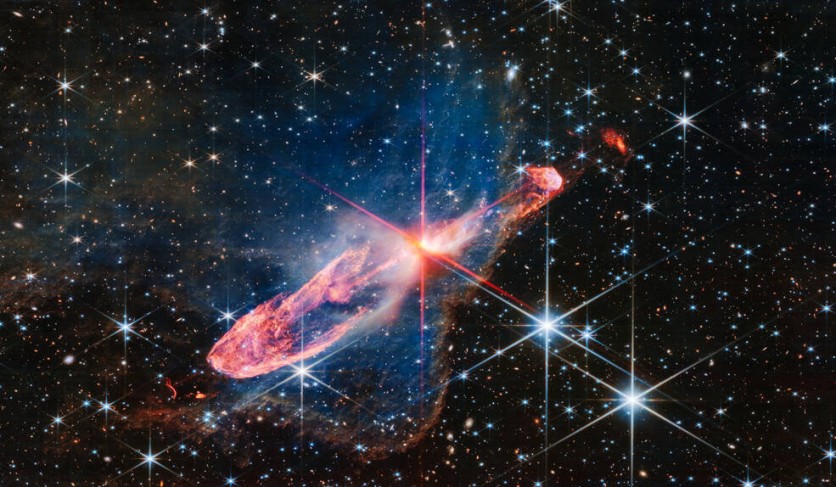NASA's James Webb Space Telescope has captured a captivating view of two actively forming young stars, known as Herbig-Haro 46/47, in high-resolution near-infrared light.
The stars are nestled in a disk of gas and dust that fuels their growth as they accumulate mass. Although the disk itself remains hidden, its shadow can be observed in the dark conical regions surrounding the central stars.

NASA's James Webb Space Telescope Captures Fiery Two-sided Lobes
The image's most fascinating feature is the fiery orange two-sided lobes extending from the actively forming stars. These lobes result from the stars ingesting and expelling gas and dust over millennia, resembling a pulsating fountain with billowing patterns.
The varying ejection speeds and material interactions are likely influenced by the stars' acquisition of material at different times. Recent ejections appear in thread-like blue below the 2 o'clock red diffraction spike, creating wavy patterns along the right side.
These ejections culminate in an uneven light purple circle within the orange region. Additionally, lighter blue, curly lines emerge on the left near the central stars, sometimes overshadowed by the bright red diffraction spike.
These jets play a vital role in star formation, regulating the stars' mass accumulation. The presence of a significant blue cloud, a region dense with dust and gas known as a Bok globule, affects the shapes of the jets expelled by the central stars.
As ejected material collides with the nebula on the lower left, interactions with the molecules within the nebula cause both the jets and the nebula to light up. Comparing the asymmetry of the two lobes, one can observe a blob-like ejecta in the upper right, appearing separate from the larger lobe.
Tentacle-like shapes seem to drift behind it, while at the lower left, an arc made up of material pushed the farthest, possibly by earlier ejections, points in a different direction, according to NASA.
Read Also : Happy 1-Year Anniversary! Look Back at NASA's James Webb Space Telescope's Most Awe-inspiring Images Yet
Angled Slightly Closer to Earth
Despite NASA's James Webb Space Telescope's image that seemed to capture Herbig-Haro 46/47 edge-on, the smaller right half is surprisingly slightly angled closer to Earth, defying conventional expectations.
The stars will complete their formation for millions of years, gradually clearing the scene of these breathtaking, multi-hued ejections. As a result, the binary stars will take center stage against the backdrop of galaxies.
Webb's ability to reveal intricate details in Herbig-Haro 46/47 stems from its relatively close distance to Earth and the composite image composed of several exposures, enhancing its depth.
Herbig-Haro 46/47, situated 1,470 light-years away in the Vela Constellation, offers a captivating insight into the dynamic process of star formation.
This high-resolution view provides valuable information for astronomers studying the early stages of star formation and the intriguing interactions that shape celestial phenomena.
Related Article : NASA's James Webb Space Telescope Catches an 'Asteroid Photobomber' Roughly the Size of Rome's Colosseum

ⓒ 2025 TECHTIMES.com All rights reserved. Do not reproduce without permission.




